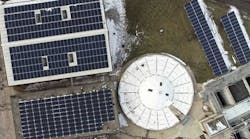ComEd connects city of Rockford, Illinois into its Community of the Future advanced energy plans
The Illinois community known as the Forest City is blazing a trail into the future of the grid.
The city of Rockford has joined with Commonwealth Edison to become that utility’s second participant in the Community of the Future program.
ComEd’s CoF program is a partnership leading to demonstration of advanced energy technologies which can drive both sustainability and resiliency. The first entity involved in the Community of the Future program was the Chicago area Bronzeville neighborhood, now the site of a microgrid cluster connecting microgrids throughout the area.
ComEd utilizes the community partnership to aim for advanced energy technology demonstrations which are grounded in community engagement. These relationships help enlighten and address community needs as well as potential decarbonization and energy resiliency projects.
"Across our region and across the country, there is a large-scale effort to make our communities more sustainable, resilient and equitable through power grid investments that integrate clean energy technologies, including renewables such as solar power, and electric vehicles to help customers reduce costs and carbon footprints," said ComEd CEO Gil Quiniones. "The Rockford Community of the Future is the type of partnership with local leaders that will help us identify and address which of these efforts will best serve the needs of this vibrant community."
The Community of the Future engagement is backed by the support of a 15-member advisory council. These include members of the Rockford Chamber of Commerce, city government, Collins Aerospace, the YMCA, Rockford Public Schools and other local entities.
In the Bronzeville neighborhood of Chicago, ComEd has been working with partners on a wide-ranging microgrid cluster connecting solar, energy storage, gen-sets, public lighting, energy efficiency and more.
-- -- --
(Rod Walton, senior editor for EnergyTech, is a 14-year veteran of covering the energy industry both as a newspaper and trade journalist. He can be reached at [email protected]).
About the Author
Rod Walton, EnergyTech Managing Editor
Managing Editor
For EnergyTech editorial inquiries, please contact Managing Editor Rod Walton at [email protected].
Rod Walton has spent 17 years covering the energy industry as a newspaper and trade journalist. He formerly was energy writer and business editor at the Tulsa World. Later, he spent six years covering the electricity power sector for Pennwell and Clarion Events. He joined Endeavor and EnergyTech in November 2021.
Walton earned his Bachelors degree in journalism from the University of Oklahoma. His career stops include the Moore American, Bartlesville Examiner-Enterprise, Wagoner Tribune and Tulsa World.
EnergyTech is focused on the mission critical and large-scale energy users and their sustainability and resiliency goals. These include the commercial and industrial sectors, as well as the military, universities, data centers and microgrids. The C&I sectors together account for close to 30 percent of greenhouse gas emissions in the U.S.
He was named Managing Editor for Microgrid Knowledge and EnergyTech starting July 1, 2023
Many large-scale energy users such as Fortune 500 companies, and mission-critical users such as military bases, universities, healthcare facilities, public safety and data centers, shifting their energy priorities to reach net-zero carbon goals within the coming decades. These include plans for renewable energy power purchase agreements, but also on-site resiliency projects such as microgrids, combined heat and power, rooftop solar, energy storage, digitalization and building efficiency upgrades.

